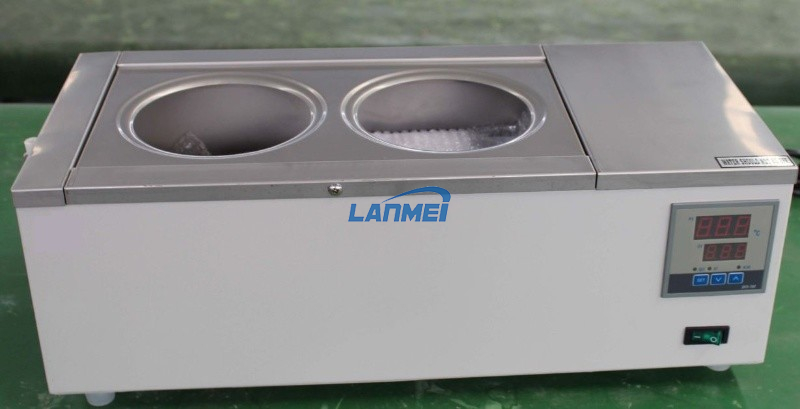Water Bath for Laboratory
- Product Description
electric-heated thermostatic water bath
The Thermotita is a perfect water bath to keep regulate the temperature of cannabis crude, oils, tinctures and distillates.
Safety:
- ETL and CE rated
- Overtemperature protection
- Overtemperature alarm
- Dry-run protection
Features & Benefits:
- Easy to clean stainless steel bath and lid
- LCD screen
- Easily set temperature and run times
Accurate Temperature Monitoring
Labnet's user friendly 6 Liter Water Baths are solidly constructed with a stainless steel, seamless chamber that resists corrosion, a stainless gable cover is included to minimize evaporation, and offers simplicity, consistency, and convenience. The optional non-toxic (non-mercury) thermometer clips onto the gable cover for accurate temperature monitoring. The chamber accommodates plastic tube racks such as the Labnet K564, K565, K566 and S2058-30 (see these in reusable Plasticware, Test tubes and accessories).
Use
This electric constant temperature water bath is for evaporation, drying, concentration, constant temperature heating test of products in colleges and universities, scientific research departments and production units.
Characteristics
1.the chamber is made of high quality cold-rolled steel plate and refined, the surface electrostatic spraying, modelling is novel, artistic.
2.The inner container and the top cover adopts high quality stainless steel, corrosion resistance to ageing, long service life.
3.immersion U heating pipe direct heating, small heat loss, and the speed of temperature rise quickly.
4.Temperature control adopts special meter, the precision is high.
三、Working environment
power voltage:220V 50Hz;
Environment temperature:5~40℃;
Environment humidity:≤85﹪;
Avoid direct sunlight;
四、Main technical parameters
| Model
Specs |
Single hole
DZKW-D-1 |
Double holes
DZKW-D-2 |
One line four holes
DZKW-D-4 |
One line six holes
DZKW-D-6 |
Double line four holes
DZKW-S-4 |
Double line six holes
DZKW-S-6 |
Double line eight holes
DZKW-S-8 |
|||||
| Rated power(W) | 300 | 500 | 1000 | 1500 | 1000 | 1500 | 2000 | |||||
| Work voltage(V) | 220V 50Hz | |||||||||||
| temperature Uniformity | ≤±1℃ | |||||||||||
| temperature fluctuation | ≤±1℃ | |||||||||||
| Temperature control range | TR+10~100℃ | |||||||||||
| Control temperature sensitivity | ≤±1℃ | |||||||||||
| Indication Error | ≤±2℃ | |||||||||||
| Work chamber size(mm) | 160×170×90 | 325×170×90 | 650×170×90 | 940×170×90 | 325×330×90 | 480×330×90 | 650×330×90 | |||||


Laboratory Water Bath: An Essential Tool for Scientific Research
In the world of scientific research and experimentation, precision and control are of paramount importance. One of the essential tools to meet these requirements is the laboratory water bath. This versatile device is widely used in various fields such as biology, chemistry and materials science, providing a stable and controlled environment for many applications.
Laboratory water baths are designed to maintain a constant temperature, allowing researchers to heat or cool samples evenly. This is especially important during experiments, where temperature fluctuations can lead to inconsistent results or even compromise the integrity of the sample. The ability to set and maintain a specific temperature makes water baths ideal for experiments such as enzyme reactions, cell culture, and solid melting.
One of the main advantages of using a water bath is its ability to provide even heat distribution. Unlike traditional heating methods that can create hot spots and uneven heating, a water bath ensures that the entire sample is at the same temperature. This uniformity is critical for experiments that require precise temperature control, such as the PCR (polymerase chain reaction) process in molecular biology, where even small deviations can affect the results.
Water baths come in a variety of sizes and configurations to meet the diverse needs of your laboratory. Some models are designed for small-scale applications, while others can accommodate larger vessels or multiple samples at once. Many modern water baths are equipped with digital controllers that allow users to set and monitor temperature with high precision. Features such as programmable settings and alarms further enhance usability, allowing researchers to focus more on their experiments instead of checking the equipment as frequently.
In addition to temperature control, water baths can be used for other laboratory processes. For example, they are often used to thaw frozen samples, grow cultures, and perform chemical reactions that require a stable thermal environment. The versatility of a water bath makes it a valuable asset to any laboratory, whether in academic research, clinical settings, or industrial applications.
Safety is another key aspect of laboratory work, and water baths are designed with this in mind. Many models have built-in safety mechanisms, such as over-temperature protection and low-water alarms, to prevent accidents and ensure the longevity of the equipment. In addition, using water as a heat transfer medium minimizes the risk of burns or other injuries that can occur with direct heating methods.
When selecting a laboratory water bath, researchers should consider a variety of factors, including the desired temperature range, capacity, and additional features that may enhance functionality. Additionally, it is crucial to select a model that is easy to clean and maintain, as hygiene is critical in a laboratory environment.
All in all, a laboratory water bath is an essential tool to support a wide range of scientific endeavors. Its ability to provide precise temperature control, even heat distribution, and versatility in a wide range of applications make it a must-have tool in laboratories around the world. As research continues to advance, the importance of reliable and efficient equipment like water baths will only grow, ensuring that scientists can work confidently and accurately. Whether you are an experienced researcher or a student just beginning your laboratory journey, understanding the importance of a water bath can enhance your experimental results and contribute to the success of your scientific endeavors.
















